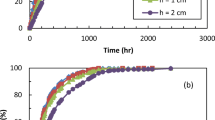Abstract
The objective of this study was to estimate the water repellency of post-boggy soils in north-eastern Poland. Potential water repellency was determined based on the water drop penetration time (WDPT) test and the molarity of an ethanol droplet (MED) test. A total of 276 soil samples with a varied organic carbon (OC) content, ranging from trace amounts in sandy subsoils to 44.4% in organic soils, were analyzed. The investigated material represents peat-muck soils (Eutri-Sapric Histsols) and muck-like soils (Arenic Gleysols, Areni-Humic Gleysols, Gleyic Arenosols). The mineral matter of the analyzed soils comprised loose sand. The obtained results indicate that peat soil formations are marked by higher potential water repellency than muck soil formations. The highest WDPT values (16 390 s) were reported in respect of an alder peat sample with 41.9% OC content, collected at a depth of 55–60 cm. In the group of muck soils, a sample with 36.7% OC content, collected at a depth of 15–20 cm, was marked by the highest water repellency (WDPT 10 492 s). The water repellency of the studied soils is dependent on organic matter content, and it is manifested only when organic matter content is higher than 20%. Soils with OC content of up to 12% show low water repellency or are hydrophilic. Organic soil formations (>12% OC) are characterized by a varied degree of water repellency, but WDPT values in excess of 2000 s are reported only in respect of soils containing more than 35% OC. A significant positive correlation between the content of organic matter, organic carbon, total nitrogen and water repellency was observed in the entire studied population (n = 276). A significant positive correlation was also found between WDPT values and the C:N ratio, while a significant negative correlation was reported in respect of \( pH_{H_2 O} \).
Similar content being viewed by others
References
Berglund K. & Persson L. 1996. Water repellence of cultivated organic soils. Acta Agric. Scand., Sec. B, Soil and Plant Science 46: 145–152.
Bisdom E.B.A., Dekker L.W. & Schoute J.F.Th. 1993. Water repellency of sieve fraction from sandy soils and relationships with organic material and soil structure. Geoderma 56: 105–118.
Buczko U., Bens O. & Hüttl R.F. 2005. Variability of soil water repellency in sandy forest soils with different stand structure under Scots pine (Pinus sylvestris) and beech (Fagus sylvatica). Geoderma 126: 317–336.
Dekker L.W. & Ritsema C.J. 1994. How water moves in a water repellent sandy soil. 1. Potential and actual water repellency. Water Resour. Res. 30: 2507–2517.
Doerr S.H. 1998. On standardizing the ‘Water Drop Penetration Time’ and the ‘Molarity of an Ethanol Droplet’ techniques to classify soil hydrophobicity: a case study using medium textured soils. Earth Surf. Process. Landforms 23: 663–668.
Doerr S.H. & Thomas A.D. 2000. The role of soil moisture in controlling water repellency: new evidence from forest soils in Portugal. J. Hydrol. 231–232: 134–147.
Doerr S.H., Shakesby R.A. & Walsh R.P.D. 2000. Soil water repellency: its causes, characteristics and hydro-geomorphological significance. Earth-Science Reviews 51: 33–65.
Horne D.J. & McIntosh J.C. 2000. Hydrophobic compounds in sands in New Zealand — extraction, characterisation and proposed mechanisms for repellency expression. J. Hydrol. 231–232: 35–46.
ISO 14235. 1998. Soil quality — Determination of organic carbon by sulfochromic oxidation.
IUSS Working Group WRB. 2006. World Reference Base for Soil Resources. 2nd edition. World Soil Resources Reports. No. 103. FAO, Rome, 115 pp.
Jaramillo D.F., Dekker L.W., Ritsema C.J. & Hendrickx J.M.H. 2000. Occurrence of soil water repellency in arid and humid climates. J. Hydrol. 231–232: 105–111.
Lichner L., Hallett P.D., Feeney D.S., Ďugová O., Šír M. & Tesař M. 2007. Field measurement of soil water repellency and its impact on water flow under different vegetation. Biologia 62: 537–541.
Okruszko H. & Ilnicki P. 2003. The moorsh horizons as quality indicators of reclaimed organic soils, pp. 1–14. In: Parent L-E. & Ilnicki P. (eds), Organic soils and peat materials for sustainable agriculture, CRC Press, Boca Raton, London, New York, Washington, D.C.
Sokołowska Z., Szajdak L. & Matyka-Sarzyńska D. 2005. Impact of the degree of secondary transformation on acid-base properties of organic compounds in mucks. Geoderma 127: 80–90.
van Reeuwijk L.P. (ed). 2002. Procedures for soil analysis. Technical Paper 9. ISRIC, FAO, Wageningen, 112 pp.
Wallis M.G. & Horne D.J. 1992. Soil water repellency. Adv. Soil Sci. 20: 91–146.
Author information
Authors and Affiliations
Corresponding author
Rights and permissions
About this article
Cite this article
Lachacz, A., Nitkiewicz, M. & Kalisz, B. Water repellency of post-boggy soils with a various content of organic matter. Biologia 64, 634–638 (2009). https://doi.org/10.2478/s11756-009-0096-5
Received:
Accepted:
Published:
Issue Date:
DOI: https://doi.org/10.2478/s11756-009-0096-5




